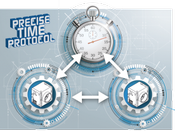
Especially for large inspection systems in industry, the Precision Time Protocol (PTP) is a very useful feature. It helps to keep many different cameras precisely synchronized. The new EXO models from SVS-Vistek have PTP integrated into the GenICam tree for easy operation.
Part of the GigE Vision standard
PTP (Precision Time Protocol) is part of the GigE Vision Standard 2.0 according to IEEE1588 a protocol for time synchronization of multiple devices in a common Ethernet network. In SVS-Vistek's EXO series, the typical PTP deviation is about 10 µs. One device must take the role of the master in the subnetwork. All other devices line up as slaves and track the master's time. If a fixed relation to standard time is to be established, an NTP or GPS device must assume the role of master. In the EXO, integration in the GenICam tree and in the flexible 4I/O model also allows control tasks that go beyond the standard.
Benefits of PTP
The Precision Time Protocol (PTP) creates a common time base of all participating cameras in the Ethernet network and allows synchronous actions. Therefore, it is particularly useful in industrial multi-camera systems and offers these advantages:
- Based on the standardized time stamp of all images, the common time base allows an exact statement to be made about when an image was exposed in relation to other images or at the scheduled time.
- PTP allows synchronous triggering and synchronous starting of scheduled events of multiple cameras.
- Especially in very complex systems, PTP helps to simplify system design and thus reduce integration costs.
Easy retrofit of PTP
SVS-Vistek's EXO models with GigE Vision all support master and slave mode as well as timed action commands. Even older EXO models with GigE interface can use this helpful feature after a firmware update (see downloads).